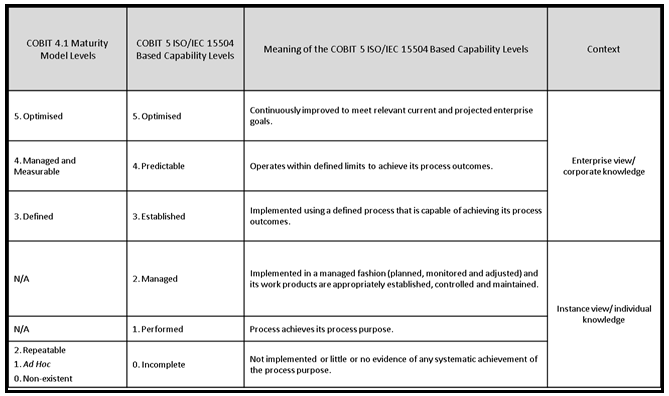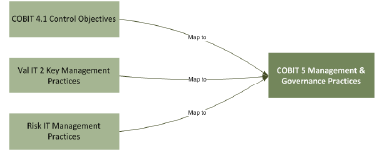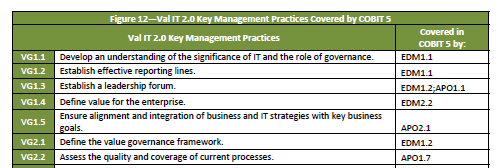Maturity model in CobiT 5:
CobiT 5 maturity model is based on the ISO/IEC 15504. This new model presents some differences (CobiT 5 2012). However, an important similarity between CobiT 4.1 and CobiT 5 Maturity model is that both models are inspired in models which were first created for the assessment of software development maturity levels. In the following figure, an overview of both maturity models is presented.

Figure 1: Maturity Models in CobiT 4.1 en CobiT 5 (CobiT 5 2012)
Val IT in CobiT 5
Different approaches have been proposed for the management of IT benefits (e.g.: Active Benefits Realization by Remenyi & Sherwood-Smith (1997), The Benefits Management Approach by Ward and Daniel (2006) and Val IT (2008). ISACA underlines the importance of benefits management and management best practices by integrating Val IT into CobiT 5. The integration of Val IT in CobiT 5 represents a step to recognize the importance of costs/benefits management.
Val IT posits good practices enabling organizations to measure, monitor and optimise value, both financial and non-financial. Val IT contains 22 processes which are part of three domains: Value Governance (VG), Portfolio Management (PM) and Investment Management (IM). These three domains have been completely incorporated in CobiT 5 (CobiT 5 2012).
Value Governance aims to ensure that management practices are connected with the organization in order to assure optimal value from IT-enabled investment. Value Governance is; for instance, incorporated in EDMI 1 and EDMI 2 (CobiT 5 2012).
Portfolio Management aims to ensure the alignment of IT-enabled investments in the portfolio and the strategic objectives of the organization. For instance, topics on PM are associated with the CobiT 5 process AP005 Manage Portfolio (CobiT 5 2012).
Investment Management aims to ensure that IT-enabled investments contribute to optimal value. For instance topics on IM are associated with processes in CobiT 5 such as: AP005 Manage Portfolio and BAI 1 Manage Programmes and Projects (CobiT 5 2012).
These three domains in CobiT 5 are differently represented and they involve different stakeholders, metrics, goals and processes (see appendix 3). Across all the processes in CobiT 5 the model based on ISO/IEC 15504 can be applied to assess maturity (CobiT, 2012). Curiously, CobiT 5 does not include the results chains method used by Thorp (1998) and in VAL IT (2008) which is useful to create transparency in the investment programmes.
The figures 2 and 3 give an overview on the integration of Val IT into CobiT 5.

Figure 2: CobiT 4.1.1, Val IT and Risk IT covered in CobiT 5 (CobiT 5 2012)

Figure 3: Val IT Practices covered in CobiT 5 (See more in Appendix 3)